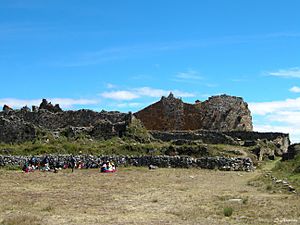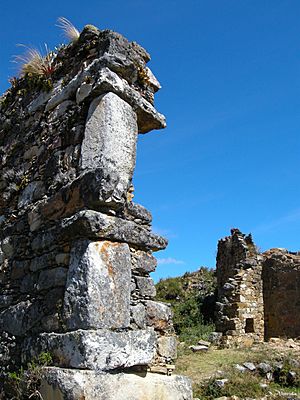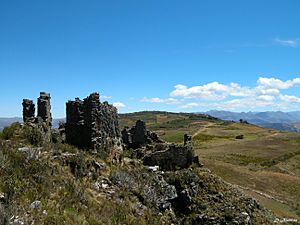Marcahuamachuco facts for kids

Marcahuamachuco is an ancient archaeological site in the La Libertad Region of Peru. It holds the remains of old buildings and structures built long before the famous Incas. Even though it's not as famous as some other ancient places, experts call it very important. They sometimes even call it the "Machu Picchu of the North" or "The Jewel of La Libertad."
Contents
History of Marcahuamachuco
Building at Marcahuamachuco started around the year 400 AD. This was during a time called the Andean Middle Horizon period. Construction continued until about 800 AD. This means it was built long before the Wari culture became powerful. It was also built many centuries before the Incas expanded their empire.
Before the Incas took over in the 14th century, Marcahuamachuco was a very important place. It was the main center for politics, money, and military power in northern Peru.
Experts believe this site was a special place for oracles. An oracle was someone who could supposedly tell the future or give advice from the gods. People also used the site for religious ceremonies and important political meetings. Later, it became a burial ground for important leaders.
Marcahuamachuco's influence spread across much of northern Peru. It even reached into what is now southern Ecuador. This importance might have come from trading with nearby cultures. Around 650 to 700 AD, it traded with the Mochica people to the west. It also traded with the Recuay culture to the south. Other trading partners included Cajamarca in the north and groups from the Maranon area.
The site was built on top of a long, flat mountain called a mesa. This mesa is about 5 kilometers (3 miles) long and 500 meters (1,640 feet) wide. It offers amazing views of the land around it. This made it a great place for defense.
Marcahuamachuco has several large building areas. These areas were surrounded by tall, curved stone walls. Some walls were as high as 12 meters (39 feet). Inside, there were remains of long hallways, rooms, and open plazas. These suggest the site was used for managing the area and for special ceremonies.
Later, between 700 and 1200 AD, people started burying bodies inside the walls. These burials added to the site's importance for ceremonies.
Marcahuamachuco likely had powerful oracles. These oracles attracted people from all over the northern Andes. This included areas that are now Peru and Ecuador. The people probably worshipped old gods, like Ataujo, and later, Catequil. Marcahuamachuco grew important at the same time the Wari culture was strong in southern Peru. The Wari culture lasted from about 400 to 1100 AD. Marcahuamachuco was likely left empty around the 15th century.
Recent studies by researchers John and Theresa Lange Topic (in 1991) suggest something interesting. They think people might have lived at the site only during certain seasons. They estimated that about 6,000 people could have lived there at most. This estimate is based on how much farmland and water were available.
Exploring Marcahuamachuco
One of the first maps of Marcahuamachuco was made in the 1700s. It was part of a document by Bishop Baltazar Jaime Martinez Compañón. Later, in the late 1800s, European travelers described and drew the site. This was when the study of archaeology was just starting to become a real profession.
In 1880, Charles Wiener published the first detailed description of the area. He also named the main building areas. Ernst Middendorf visited Marcahuamachuco in 1887. He described its main parts and even compared it to another ancient site called Kuelap.
The first official archaeological study at Marcahuamachuco happened in 1900. Max Uhle and Julio C. Tello worked there for three months. They were supported by the University of California, Berkeley. Uhle took photos of the site. He also corrected earlier maps made by Wiener.
After them, Theodore McCown from the same university continued the research in 1941-42. He looked at Uhle's writings and old items stored at the university's museum. McCown also spent two years digging between the large galleries. His published work described the site in more detail. He drew more exact maps and created a timeline for Marcahuamachuco's cultural development.
In 1944, archaeologist Hans Horkheimer shared photos from Marcahuamachuco. These photos showed stone heads that looked like those from the Chavín culture. John Thatcher, who was a student of McCown, continued research in 1968-69 and 1973–74. He focused on figuring out the different time periods of the culture. He did this by studying the styles of pottery found there.
Since 1981, a Canadian team has been working on the Huamachuco Archaeological Project. They are dedicated to studying the ancient history of the area. Their researchers have gathered a lot of information and drawn conclusions about the site.
The Marcahuamachuco Site
Marcahuamachuco is located high up in the mountains. It sits where three mountain valleys meet. The site is more than 3,200 meters (10,000 feet) above sea level. It covers over three kilometers (nearly 2 miles) of land.
The site is famous for its huge "castillos" (castles). It also has unique circular structures with double walls. Over many centuries, natural forces like wind and rain have damaged the ruins. Today, they face more threats. These include animals grazing, plants growing on the walls, and not enough care or protection.
The location of the site, in the northern Peruvian highlands, used to be hard to reach. But now, a new road makes it easier. It's about a three-and-a-half-hour drive from the city of Trujillo. Trujillo is the third-largest city on Peru's Pacific coast. It's also home to important ancient Moche sites.
The homes at Marcahuamachuco were multi-story galleries. These buildings originally housed many different families.
Protecting Marcahuamachuco
The huge size and impressive buildings of Marcahuamachuco show how important it was. This importance has led the Peruvian Government to help protect this massive archaeological site. They have recently started funding a big project to save what visitors call "The Machu Picchu of the North."
More recently, the Minister of Culture, Juan Ossio, highlighted the site's importance. He named Marcahuamachuco, Wanuku Pampa, and Kuelap as major archaeological tourist spots. He said they are just as important as Machu Picchu.
In May 2011, the Global Heritage Fund (GHF) announced its support. They said they would provide money and expert help for conservation work at Marcahuamachuco.
See also
 In Spanish: Marcahuamachuco para niños
In Spanish: Marcahuamachuco para niños



